Unit 11 Research Report: Cultural Diversity at Marks & Spencer, UK
VerifiedAdded on 2022/12/28
|18
|3828
|90
Report
AI Summary
This report presents a research project focused on managing cultural diversity within the workplace, using Marks & Spencer as a case study. The report begins with an executive summary, introduction including the organization's background, research aims, objectives, questions, and rationale. A thorough literature review explores the concept of managing cultural diversity, its influence on employee performance, and the advantages for management. The methodology section details the research philosophy, approach, methods, and data collection techniques, including the use of questionnaires. Data analysis and interpretations, including frequency distribution analysis, are provided, along with research outcomes and recommendations. The report also includes a reflection on the methodology and alternative approaches. The findings highlight the importance of managing diverse cultural backgrounds for organizational success, employee performance, and the benefits of equality and diversity initiatives. The report concludes with key insights and recommendations for effectively managing cultural diversity, supported by the data analysis and literature review.
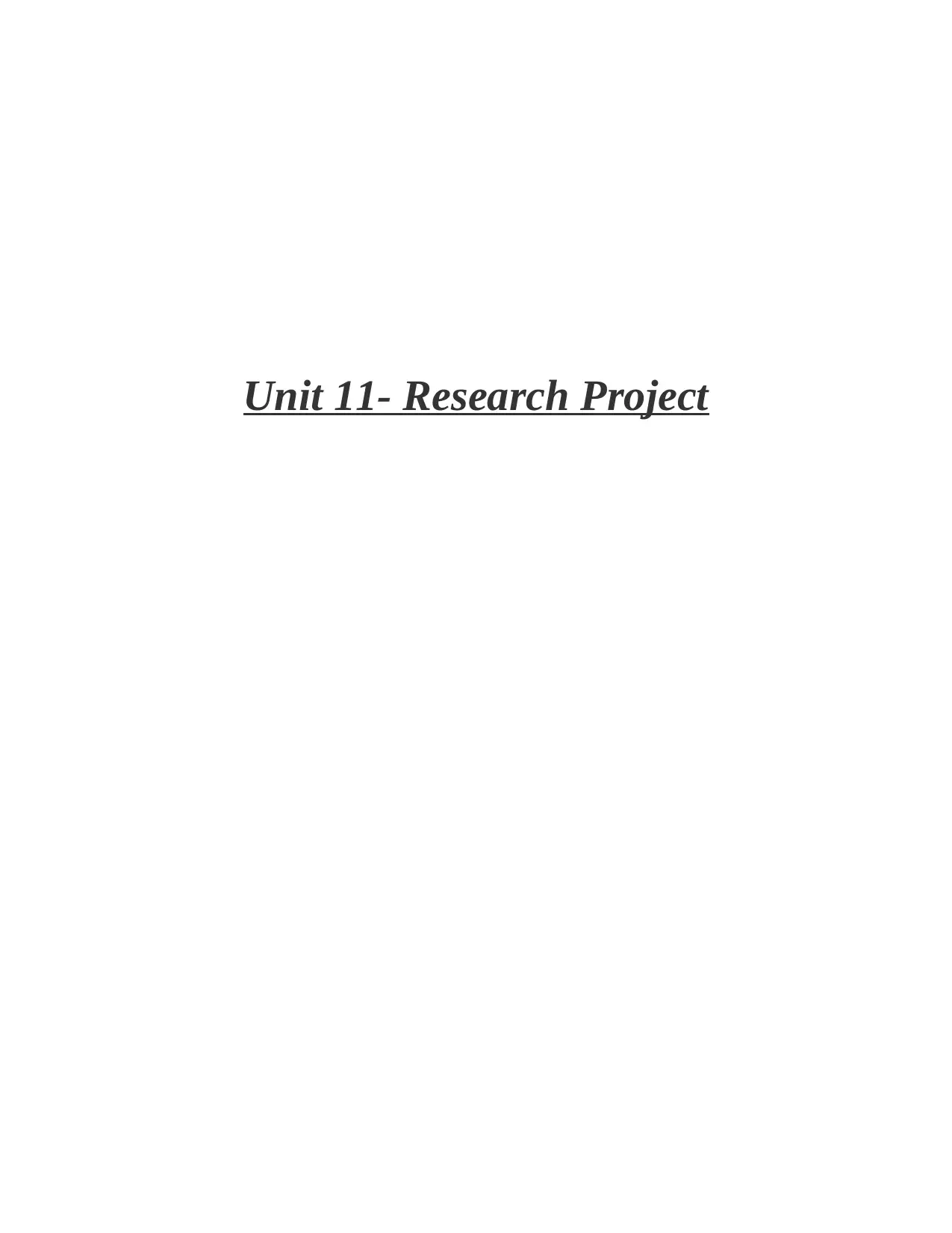
Unit 11- Research Project
Paraphrase This Document
Need a fresh take? Get an instant paraphrase of this document with our AI Paraphraser
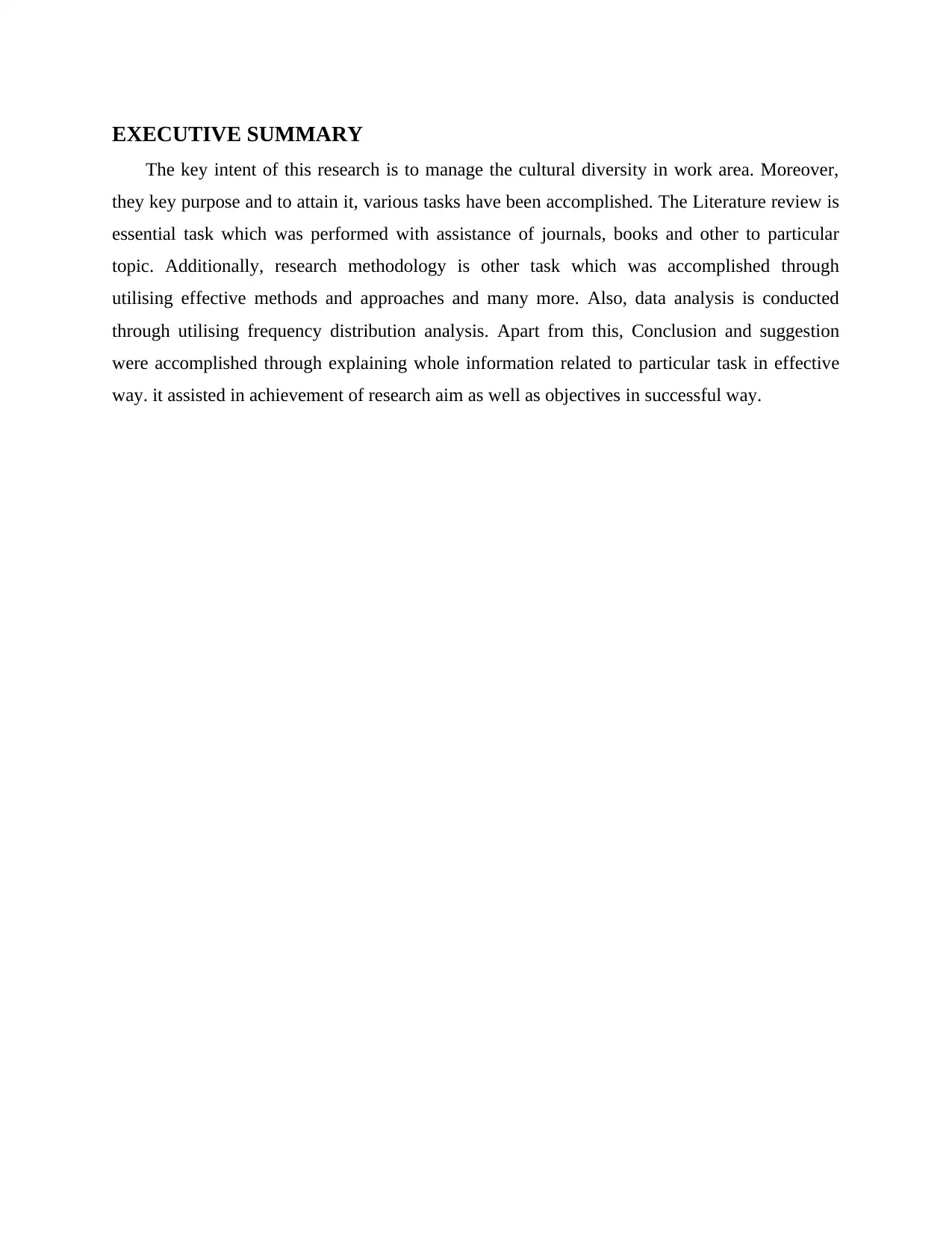
EXECUTIVE SUMMARY
The key intent of this research is to manage the cultural diversity in work area. Moreover,
they key purpose and to attain it, various tasks have been accomplished. The Literature review is
essential task which was performed with assistance of journals, books and other to particular
topic. Additionally, research methodology is other task which was accomplished through
utilising effective methods and approaches and many more. Also, data analysis is conducted
through utilising frequency distribution analysis. Apart from this, Conclusion and suggestion
were accomplished through explaining whole information related to particular task in effective
way. it assisted in achievement of research aim as well as objectives in successful way.
The key intent of this research is to manage the cultural diversity in work area. Moreover,
they key purpose and to attain it, various tasks have been accomplished. The Literature review is
essential task which was performed with assistance of journals, books and other to particular
topic. Additionally, research methodology is other task which was accomplished through
utilising effective methods and approaches and many more. Also, data analysis is conducted
through utilising frequency distribution analysis. Apart from this, Conclusion and suggestion
were accomplished through explaining whole information related to particular task in effective
way. it assisted in achievement of research aim as well as objectives in successful way.
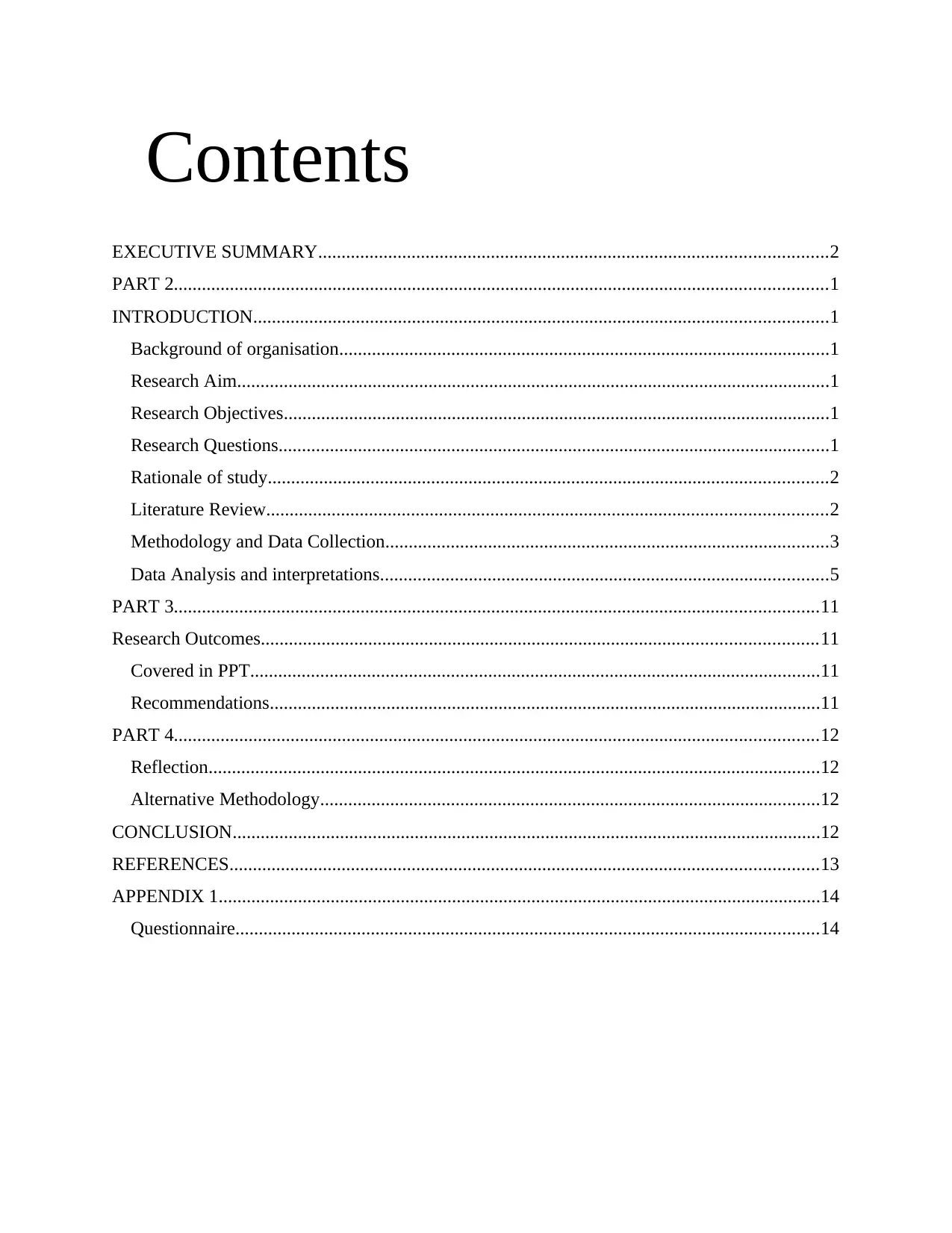
Contents
EXECUTIVE SUMMARY.............................................................................................................2
PART 2............................................................................................................................................1
INTRODUCTION...........................................................................................................................1
Background of organisation.........................................................................................................1
Research Aim...............................................................................................................................1
Research Objectives.....................................................................................................................1
Research Questions......................................................................................................................1
Rationale of study........................................................................................................................2
Literature Review........................................................................................................................2
Methodology and Data Collection...............................................................................................3
Data Analysis and interpretations................................................................................................5
PART 3..........................................................................................................................................11
Research Outcomes.......................................................................................................................11
Covered in PPT..........................................................................................................................11
Recommendations......................................................................................................................11
PART 4..........................................................................................................................................12
Reflection...................................................................................................................................12
Alternative Methodology...........................................................................................................12
CONCLUSION..............................................................................................................................12
REFERENCES..............................................................................................................................13
APPENDIX 1.................................................................................................................................14
Questionnaire.............................................................................................................................14
EXECUTIVE SUMMARY.............................................................................................................2
PART 2............................................................................................................................................1
INTRODUCTION...........................................................................................................................1
Background of organisation.........................................................................................................1
Research Aim...............................................................................................................................1
Research Objectives.....................................................................................................................1
Research Questions......................................................................................................................1
Rationale of study........................................................................................................................2
Literature Review........................................................................................................................2
Methodology and Data Collection...............................................................................................3
Data Analysis and interpretations................................................................................................5
PART 3..........................................................................................................................................11
Research Outcomes.......................................................................................................................11
Covered in PPT..........................................................................................................................11
Recommendations......................................................................................................................11
PART 4..........................................................................................................................................12
Reflection...................................................................................................................................12
Alternative Methodology...........................................................................................................12
CONCLUSION..............................................................................................................................12
REFERENCES..............................................................................................................................13
APPENDIX 1.................................................................................................................................14
Questionnaire.............................................................................................................................14
⊘ This is a preview!⊘
Do you want full access?
Subscribe today to unlock all pages.

Trusted by 1+ million students worldwide
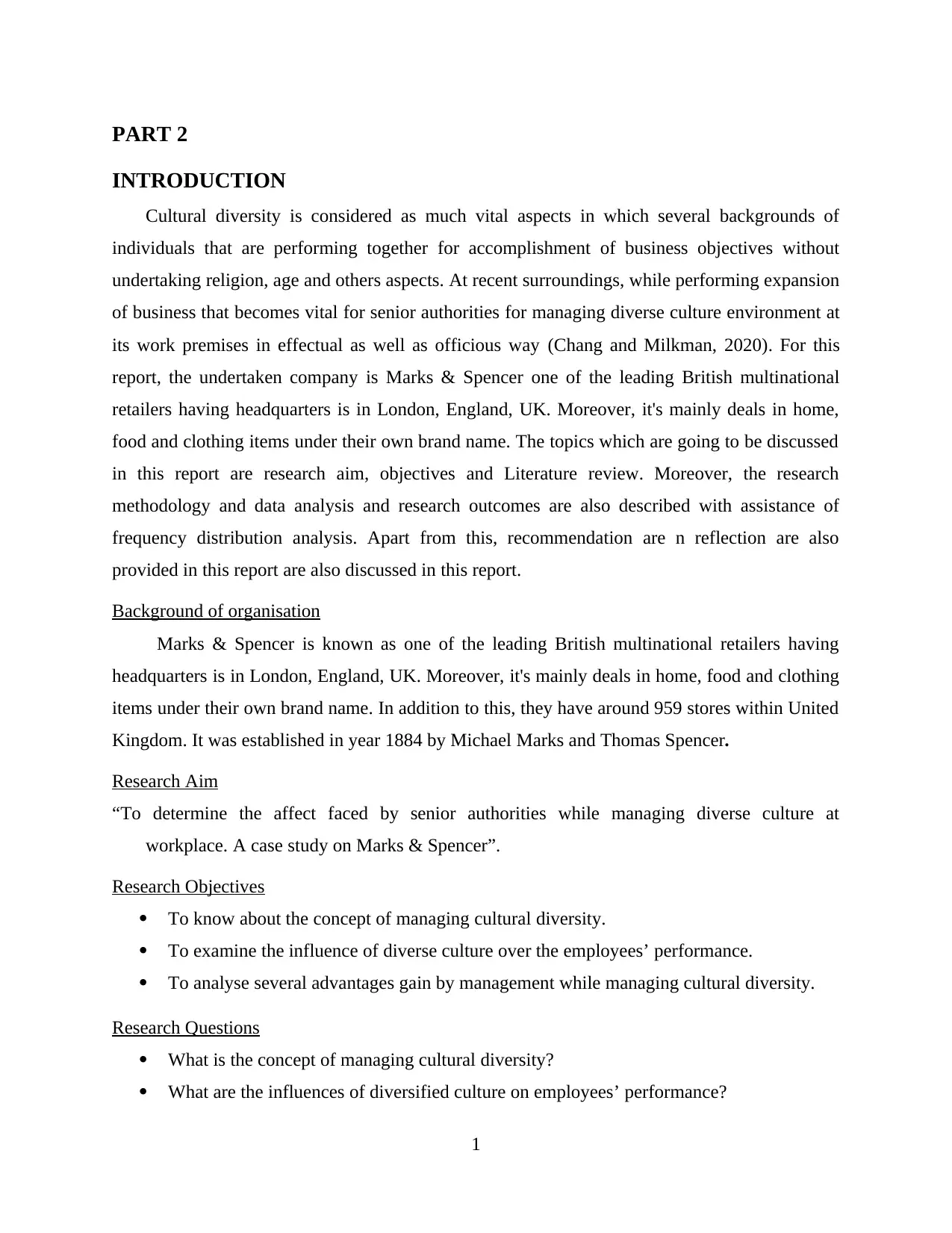
PART 2
INTRODUCTION
Cultural diversity is considered as much vital aspects in which several backgrounds of
individuals that are performing together for accomplishment of business objectives without
undertaking religion, age and others aspects. At recent surroundings, while performing expansion
of business that becomes vital for senior authorities for managing diverse culture environment at
its work premises in effectual as well as officious way (Chang and Milkman, 2020). For this
report, the undertaken company is Marks & Spencer one of the leading British multinational
retailers having headquarters is in London, England, UK. Moreover, it's mainly deals in home,
food and clothing items under their own brand name. The topics which are going to be discussed
in this report are research aim, objectives and Literature review. Moreover, the research
methodology and data analysis and research outcomes are also described with assistance of
frequency distribution analysis. Apart from this, recommendation are n reflection are also
provided in this report are also discussed in this report.
Background of organisation
Marks & Spencer is known as one of the leading British multinational retailers having
headquarters is in London, England, UK. Moreover, it's mainly deals in home, food and clothing
items under their own brand name. In addition to this, they have around 959 stores within United
Kingdom. It was established in year 1884 by Michael Marks and Thomas Spencer.
Research Aim
“To determine the affect faced by senior authorities while managing diverse culture at
workplace. A case study on Marks & Spencer”.
Research Objectives
To know about the concept of managing cultural diversity.
To examine the influence of diverse culture over the employees’ performance.
To analyse several advantages gain by management while managing cultural diversity.
Research Questions
What is the concept of managing cultural diversity?
What are the influences of diversified culture on employees’ performance?
1
INTRODUCTION
Cultural diversity is considered as much vital aspects in which several backgrounds of
individuals that are performing together for accomplishment of business objectives without
undertaking religion, age and others aspects. At recent surroundings, while performing expansion
of business that becomes vital for senior authorities for managing diverse culture environment at
its work premises in effectual as well as officious way (Chang and Milkman, 2020). For this
report, the undertaken company is Marks & Spencer one of the leading British multinational
retailers having headquarters is in London, England, UK. Moreover, it's mainly deals in home,
food and clothing items under their own brand name. The topics which are going to be discussed
in this report are research aim, objectives and Literature review. Moreover, the research
methodology and data analysis and research outcomes are also described with assistance of
frequency distribution analysis. Apart from this, recommendation are n reflection are also
provided in this report are also discussed in this report.
Background of organisation
Marks & Spencer is known as one of the leading British multinational retailers having
headquarters is in London, England, UK. Moreover, it's mainly deals in home, food and clothing
items under their own brand name. In addition to this, they have around 959 stores within United
Kingdom. It was established in year 1884 by Michael Marks and Thomas Spencer.
Research Aim
“To determine the affect faced by senior authorities while managing diverse culture at
workplace. A case study on Marks & Spencer”.
Research Objectives
To know about the concept of managing cultural diversity.
To examine the influence of diverse culture over the employees’ performance.
To analyse several advantages gain by management while managing cultural diversity.
Research Questions
What is the concept of managing cultural diversity?
What are the influences of diversified culture on employees’ performance?
1
Paraphrase This Document
Need a fresh take? Get an instant paraphrase of this document with our AI Paraphraser
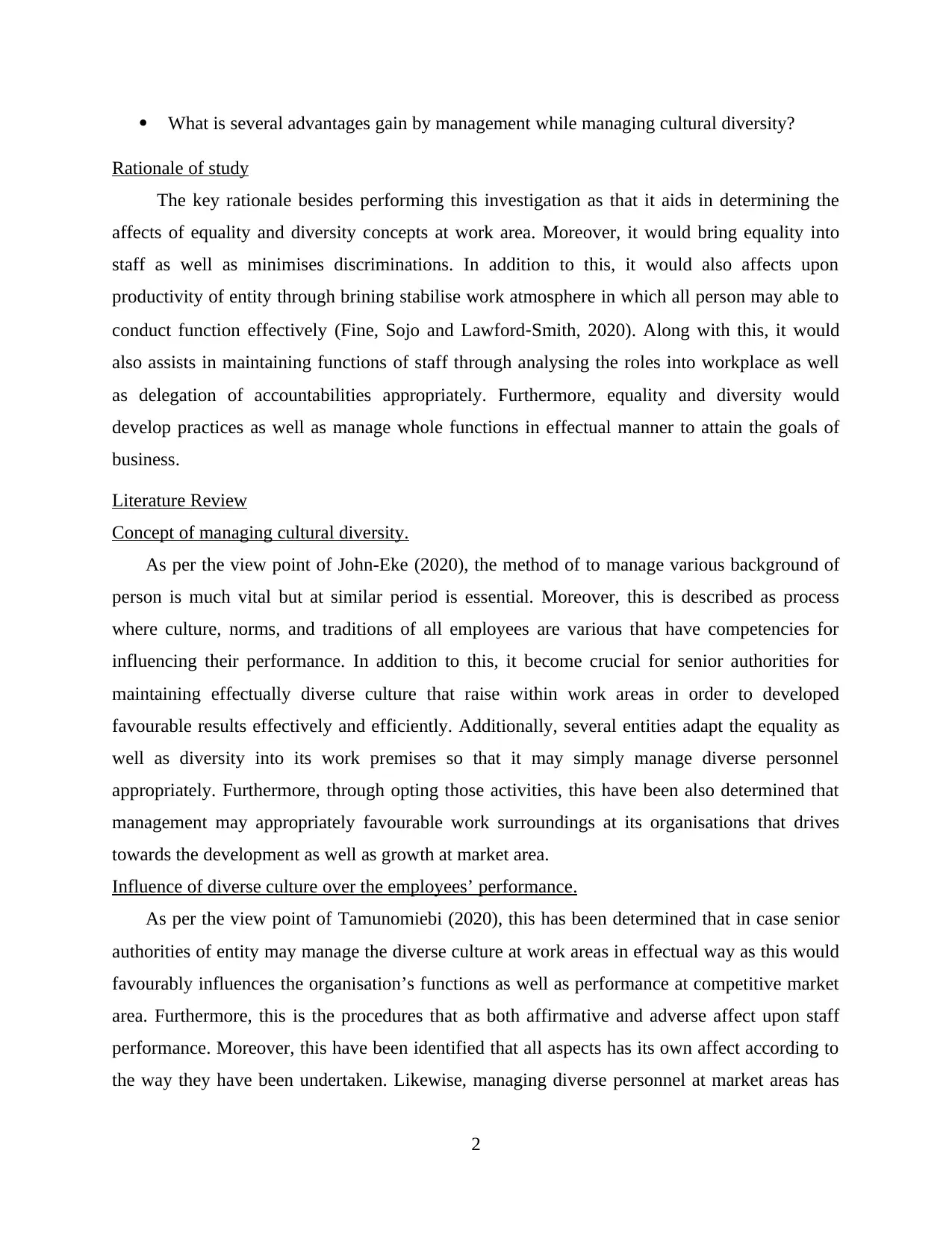
What is several advantages gain by management while managing cultural diversity?
Rationale of study
The key rationale besides performing this investigation as that it aids in determining the
affects of equality and diversity concepts at work area. Moreover, it would bring equality into
staff as well as minimises discriminations. In addition to this, it would also affects upon
productivity of entity through brining stabilise work atmosphere in which all person may able to
conduct function effectively (Fine, Sojo and Lawford‐Smith, 2020). Along with this, it would
also assists in maintaining functions of staff through analysing the roles into workplace as well
as delegation of accountabilities appropriately. Furthermore, equality and diversity would
develop practices as well as manage whole functions in effectual manner to attain the goals of
business.
Literature Review
Concept of managing cultural diversity.
As per the view point of John-Eke (2020), the method of to manage various background of
person is much vital but at similar period is essential. Moreover, this is described as process
where culture, norms, and traditions of all employees are various that have competencies for
influencing their performance. In addition to this, it become crucial for senior authorities for
maintaining effectually diverse culture that raise within work areas in order to developed
favourable results effectively and efficiently. Additionally, several entities adapt the equality as
well as diversity into its work premises so that it may simply manage diverse personnel
appropriately. Furthermore, through opting those activities, this have been also determined that
management may appropriately favourable work surroundings at its organisations that drives
towards the development as well as growth at market area.
Influence of diverse culture over the employees’ performance.
As per the view point of Tamunomiebi (2020), this has been determined that in case senior
authorities of entity may manage the diverse culture at work areas in effectual way as this would
favourably influences the organisation’s functions as well as performance at competitive market
area. Furthermore, this is the procedures that as both affirmative and adverse affect upon staff
performance. Moreover, this have been identified that all aspects has its own affect according to
the way they have been undertaken. Likewise, managing diverse personnel at market areas has
2
Rationale of study
The key rationale besides performing this investigation as that it aids in determining the
affects of equality and diversity concepts at work area. Moreover, it would bring equality into
staff as well as minimises discriminations. In addition to this, it would also affects upon
productivity of entity through brining stabilise work atmosphere in which all person may able to
conduct function effectively (Fine, Sojo and Lawford‐Smith, 2020). Along with this, it would
also assists in maintaining functions of staff through analysing the roles into workplace as well
as delegation of accountabilities appropriately. Furthermore, equality and diversity would
develop practices as well as manage whole functions in effectual manner to attain the goals of
business.
Literature Review
Concept of managing cultural diversity.
As per the view point of John-Eke (2020), the method of to manage various background of
person is much vital but at similar period is essential. Moreover, this is described as process
where culture, norms, and traditions of all employees are various that have competencies for
influencing their performance. In addition to this, it become crucial for senior authorities for
maintaining effectually diverse culture that raise within work areas in order to developed
favourable results effectively and efficiently. Additionally, several entities adapt the equality as
well as diversity into its work premises so that it may simply manage diverse personnel
appropriately. Furthermore, through opting those activities, this have been also determined that
management may appropriately favourable work surroundings at its organisations that drives
towards the development as well as growth at market area.
Influence of diverse culture over the employees’ performance.
As per the view point of Tamunomiebi (2020), this has been determined that in case senior
authorities of entity may manage the diverse culture at work areas in effectual way as this would
favourably influences the organisation’s functions as well as performance at competitive market
area. Furthermore, this is the procedures that as both affirmative and adverse affect upon staff
performance. Moreover, this have been identified that all aspects has its own affect according to
the way they have been undertaken. Likewise, managing diverse personnel at market areas has
2
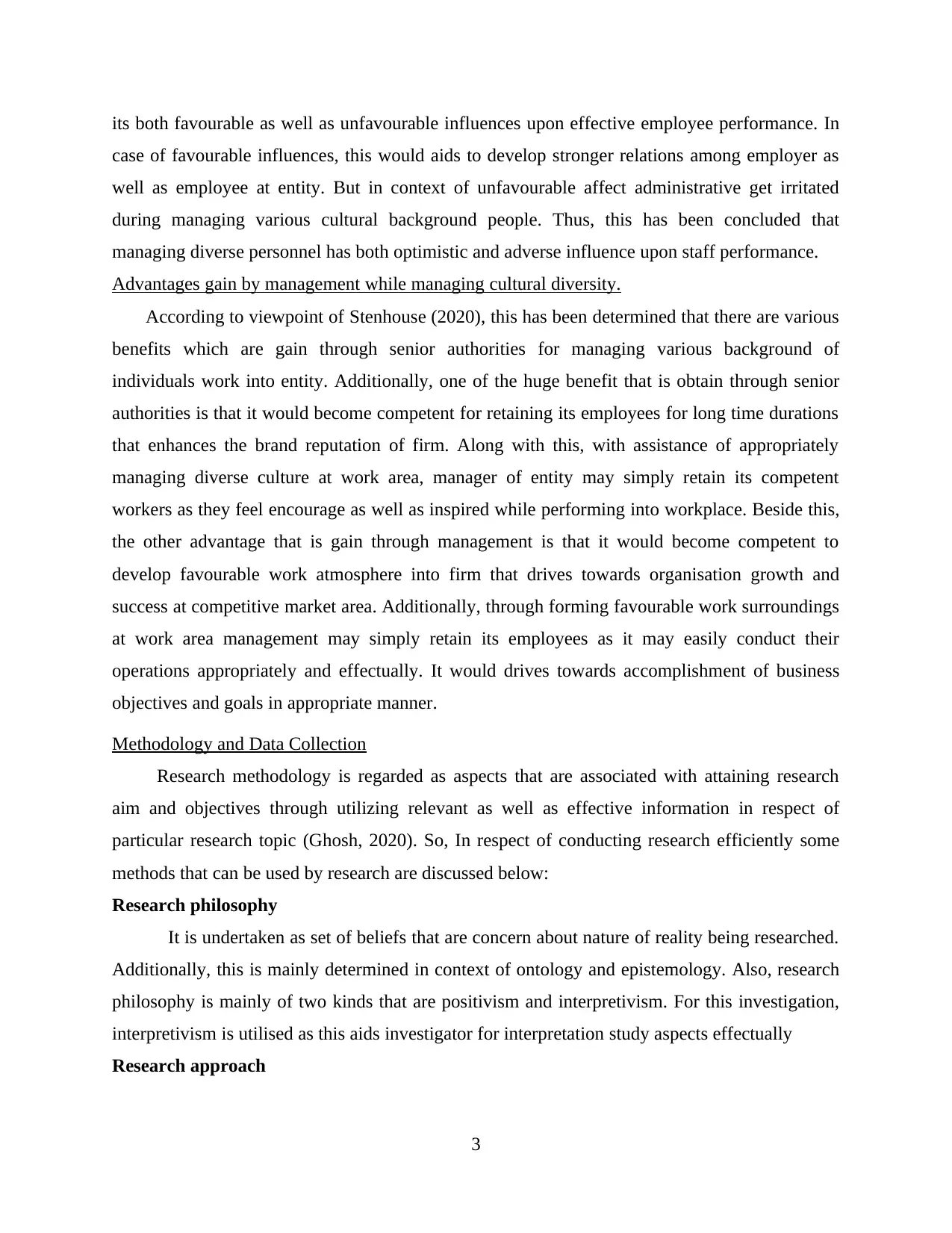
its both favourable as well as unfavourable influences upon effective employee performance. In
case of favourable influences, this would aids to develop stronger relations among employer as
well as employee at entity. But in context of unfavourable affect administrative get irritated
during managing various cultural background people. Thus, this has been concluded that
managing diverse personnel has both optimistic and adverse influence upon staff performance.
Advantages gain by management while managing cultural diversity.
According to viewpoint of Stenhouse (2020), this has been determined that there are various
benefits which are gain through senior authorities for managing various background of
individuals work into entity. Additionally, one of the huge benefit that is obtain through senior
authorities is that it would become competent for retaining its employees for long time durations
that enhances the brand reputation of firm. Along with this, with assistance of appropriately
managing diverse culture at work area, manager of entity may simply retain its competent
workers as they feel encourage as well as inspired while performing into workplace. Beside this,
the other advantage that is gain through management is that it would become competent to
develop favourable work atmosphere into firm that drives towards organisation growth and
success at competitive market area. Additionally, through forming favourable work surroundings
at work area management may simply retain its employees as it may easily conduct their
operations appropriately and effectually. It would drives towards accomplishment of business
objectives and goals in appropriate manner.
Methodology and Data Collection
Research methodology is regarded as aspects that are associated with attaining research
aim and objectives through utilizing relevant as well as effective information in respect of
particular research topic (Ghosh, 2020). So, In respect of conducting research efficiently some
methods that can be used by research are discussed below:
Research philosophy
It is undertaken as set of beliefs that are concern about nature of reality being researched.
Additionally, this is mainly determined in context of ontology and epistemology. Also, research
philosophy is mainly of two kinds that are positivism and interpretivism. For this investigation,
interpretivism is utilised as this aids investigator for interpretation study aspects effectually
Research approach
3
case of favourable influences, this would aids to develop stronger relations among employer as
well as employee at entity. But in context of unfavourable affect administrative get irritated
during managing various cultural background people. Thus, this has been concluded that
managing diverse personnel has both optimistic and adverse influence upon staff performance.
Advantages gain by management while managing cultural diversity.
According to viewpoint of Stenhouse (2020), this has been determined that there are various
benefits which are gain through senior authorities for managing various background of
individuals work into entity. Additionally, one of the huge benefit that is obtain through senior
authorities is that it would become competent for retaining its employees for long time durations
that enhances the brand reputation of firm. Along with this, with assistance of appropriately
managing diverse culture at work area, manager of entity may simply retain its competent
workers as they feel encourage as well as inspired while performing into workplace. Beside this,
the other advantage that is gain through management is that it would become competent to
develop favourable work atmosphere into firm that drives towards organisation growth and
success at competitive market area. Additionally, through forming favourable work surroundings
at work area management may simply retain its employees as it may easily conduct their
operations appropriately and effectually. It would drives towards accomplishment of business
objectives and goals in appropriate manner.
Methodology and Data Collection
Research methodology is regarded as aspects that are associated with attaining research
aim and objectives through utilizing relevant as well as effective information in respect of
particular research topic (Ghosh, 2020). So, In respect of conducting research efficiently some
methods that can be used by research are discussed below:
Research philosophy
It is undertaken as set of beliefs that are concern about nature of reality being researched.
Additionally, this is mainly determined in context of ontology and epistemology. Also, research
philosophy is mainly of two kinds that are positivism and interpretivism. For this investigation,
interpretivism is utilised as this aids investigator for interpretation study aspects effectually
Research approach
3
⊘ This is a preview!⊘
Do you want full access?
Subscribe today to unlock all pages.

Trusted by 1+ million students worldwide
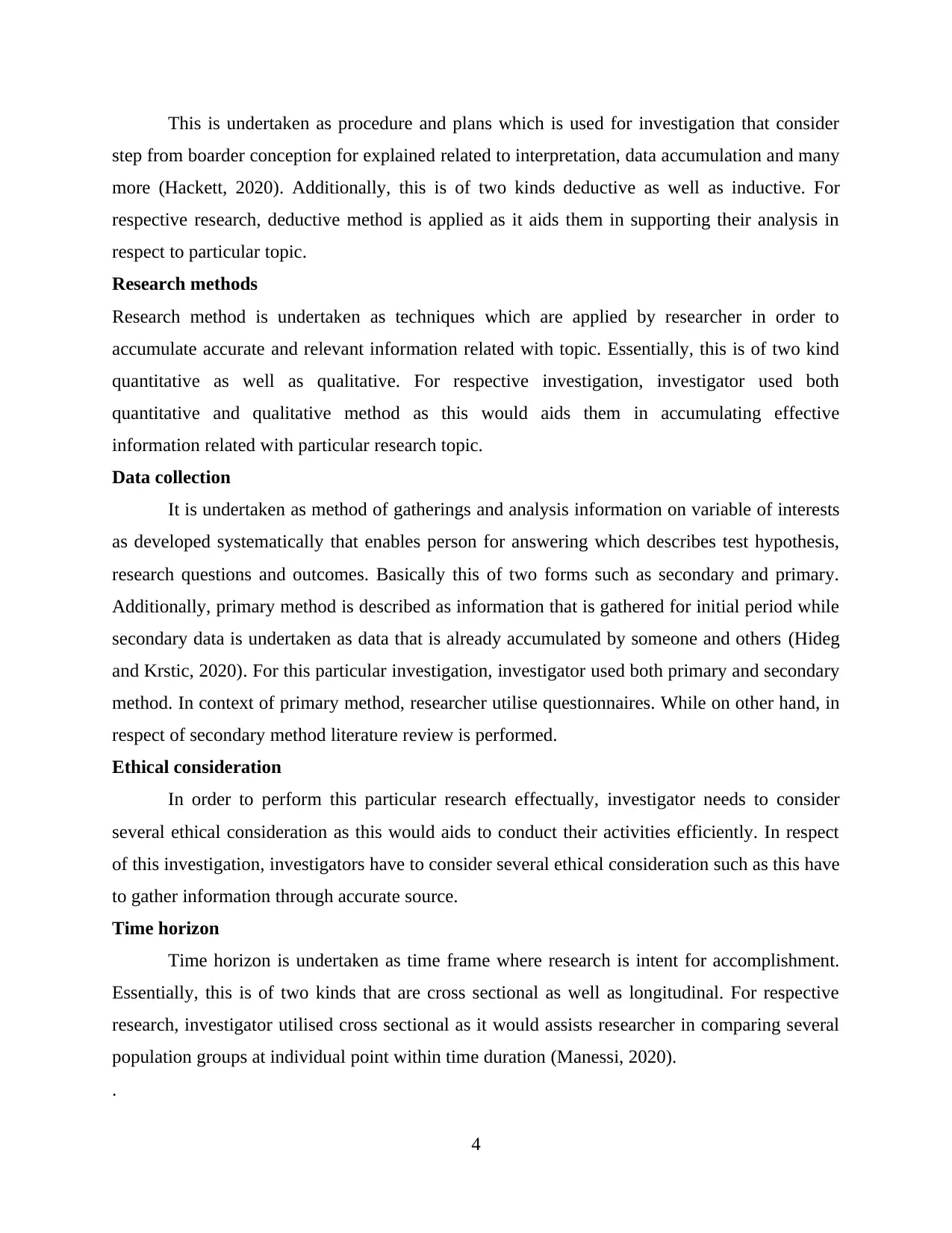
This is undertaken as procedure and plans which is used for investigation that consider
step from boarder conception for explained related to interpretation, data accumulation and many
more (Hackett, 2020). Additionally, this is of two kinds deductive as well as inductive. For
respective research, deductive method is applied as it aids them in supporting their analysis in
respect to particular topic.
Research methods
Research method is undertaken as techniques which are applied by researcher in order to
accumulate accurate and relevant information related with topic. Essentially, this is of two kind
quantitative as well as qualitative. For respective investigation, investigator used both
quantitative and qualitative method as this would aids them in accumulating effective
information related with particular research topic.
Data collection
It is undertaken as method of gatherings and analysis information on variable of interests
as developed systematically that enables person for answering which describes test hypothesis,
research questions and outcomes. Basically this of two forms such as secondary and primary.
Additionally, primary method is described as information that is gathered for initial period while
secondary data is undertaken as data that is already accumulated by someone and others (Hideg
and Krstic, 2020). For this particular investigation, investigator used both primary and secondary
method. In context of primary method, researcher utilise questionnaires. While on other hand, in
respect of secondary method literature review is performed.
Ethical consideration
In order to perform this particular research effectually, investigator needs to consider
several ethical consideration as this would aids to conduct their activities efficiently. In respect
of this investigation, investigators have to consider several ethical consideration such as this have
to gather information through accurate source.
Time horizon
Time horizon is undertaken as time frame where research is intent for accomplishment.
Essentially, this is of two kinds that are cross sectional as well as longitudinal. For respective
research, investigator utilised cross sectional as it would assists researcher in comparing several
population groups at individual point within time duration (Manessi, 2020).
.
4
step from boarder conception for explained related to interpretation, data accumulation and many
more (Hackett, 2020). Additionally, this is of two kinds deductive as well as inductive. For
respective research, deductive method is applied as it aids them in supporting their analysis in
respect to particular topic.
Research methods
Research method is undertaken as techniques which are applied by researcher in order to
accumulate accurate and relevant information related with topic. Essentially, this is of two kind
quantitative as well as qualitative. For respective investigation, investigator used both
quantitative and qualitative method as this would aids them in accumulating effective
information related with particular research topic.
Data collection
It is undertaken as method of gatherings and analysis information on variable of interests
as developed systematically that enables person for answering which describes test hypothesis,
research questions and outcomes. Basically this of two forms such as secondary and primary.
Additionally, primary method is described as information that is gathered for initial period while
secondary data is undertaken as data that is already accumulated by someone and others (Hideg
and Krstic, 2020). For this particular investigation, investigator used both primary and secondary
method. In context of primary method, researcher utilise questionnaires. While on other hand, in
respect of secondary method literature review is performed.
Ethical consideration
In order to perform this particular research effectually, investigator needs to consider
several ethical consideration as this would aids to conduct their activities efficiently. In respect
of this investigation, investigators have to consider several ethical consideration such as this have
to gather information through accurate source.
Time horizon
Time horizon is undertaken as time frame where research is intent for accomplishment.
Essentially, this is of two kinds that are cross sectional as well as longitudinal. For respective
research, investigator utilised cross sectional as it would assists researcher in comparing several
population groups at individual point within time duration (Manessi, 2020).
.
4
Paraphrase This Document
Need a fresh take? Get an instant paraphrase of this document with our AI Paraphraser
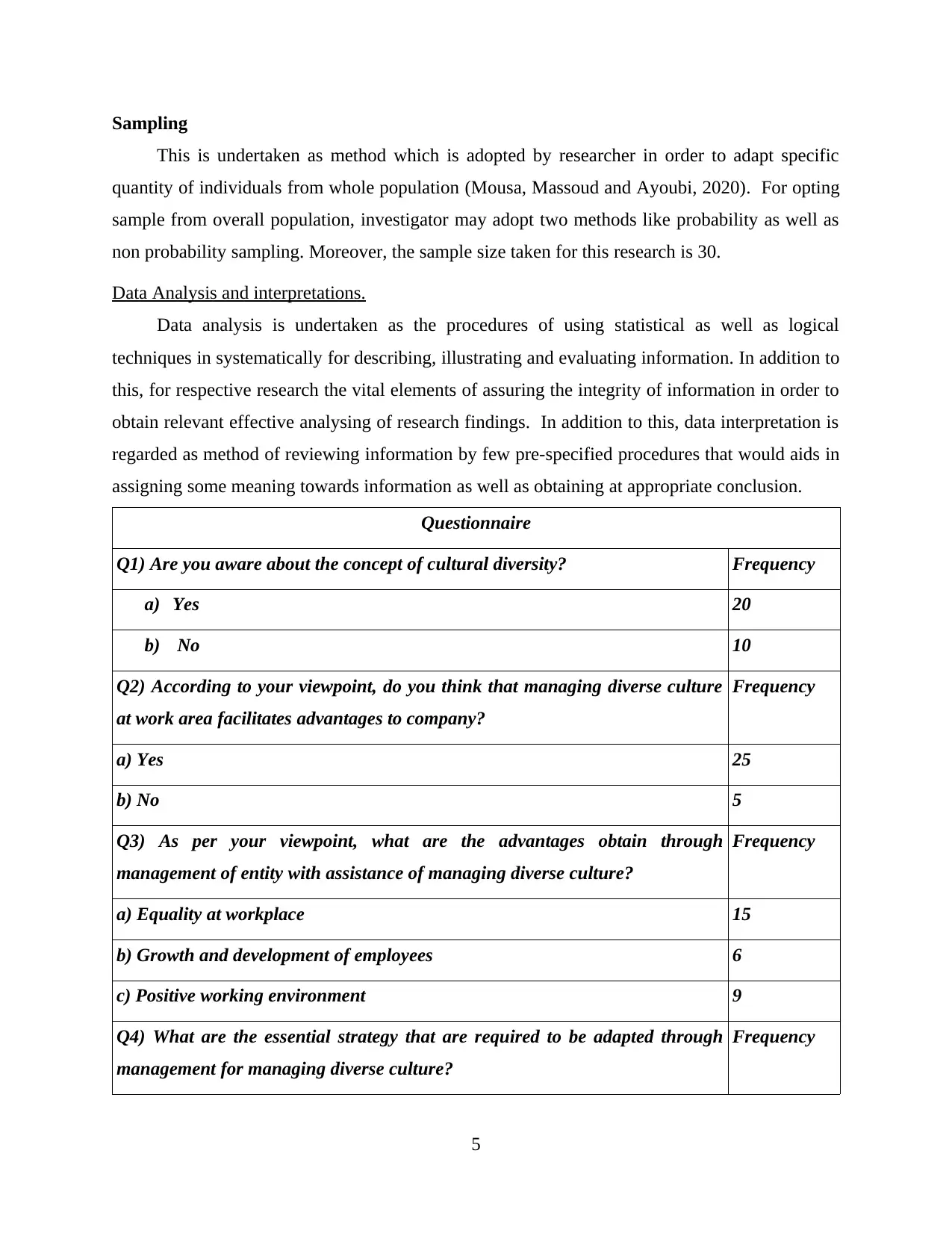
Sampling
This is undertaken as method which is adopted by researcher in order to adapt specific
quantity of individuals from whole population (Mousa, Massoud and Ayoubi, 2020). For opting
sample from overall population, investigator may adopt two methods like probability as well as
non probability sampling. Moreover, the sample size taken for this research is 30.
Data Analysis and interpretations.
Data analysis is undertaken as the procedures of using statistical as well as logical
techniques in systematically for describing, illustrating and evaluating information. In addition to
this, for respective research the vital elements of assuring the integrity of information in order to
obtain relevant effective analysing of research findings. In addition to this, data interpretation is
regarded as method of reviewing information by few pre-specified procedures that would aids in
assigning some meaning towards information as well as obtaining at appropriate conclusion.
Questionnaire
Q1) Are you aware about the concept of cultural diversity? Frequency
a) Yes 20
b) No 10
Q2) According to your viewpoint, do you think that managing diverse culture
at work area facilitates advantages to company?
Frequency
a) Yes 25
b) No 5
Q3) As per your viewpoint, what are the advantages obtain through
management of entity with assistance of managing diverse culture?
Frequency
a) Equality at workplace 15
b) Growth and development of employees 6
c) Positive working environment 9
Q4) What are the essential strategy that are required to be adapted through
management for managing diverse culture?
Frequency
5
This is undertaken as method which is adopted by researcher in order to adapt specific
quantity of individuals from whole population (Mousa, Massoud and Ayoubi, 2020). For opting
sample from overall population, investigator may adopt two methods like probability as well as
non probability sampling. Moreover, the sample size taken for this research is 30.
Data Analysis and interpretations.
Data analysis is undertaken as the procedures of using statistical as well as logical
techniques in systematically for describing, illustrating and evaluating information. In addition to
this, for respective research the vital elements of assuring the integrity of information in order to
obtain relevant effective analysing of research findings. In addition to this, data interpretation is
regarded as method of reviewing information by few pre-specified procedures that would aids in
assigning some meaning towards information as well as obtaining at appropriate conclusion.
Questionnaire
Q1) Are you aware about the concept of cultural diversity? Frequency
a) Yes 20
b) No 10
Q2) According to your viewpoint, do you think that managing diverse culture
at work area facilitates advantages to company?
Frequency
a) Yes 25
b) No 5
Q3) As per your viewpoint, what are the advantages obtain through
management of entity with assistance of managing diverse culture?
Frequency
a) Equality at workplace 15
b) Growth and development of employees 6
c) Positive working environment 9
Q4) What are the essential strategy that are required to be adapted through
management for managing diverse culture?
Frequency
5
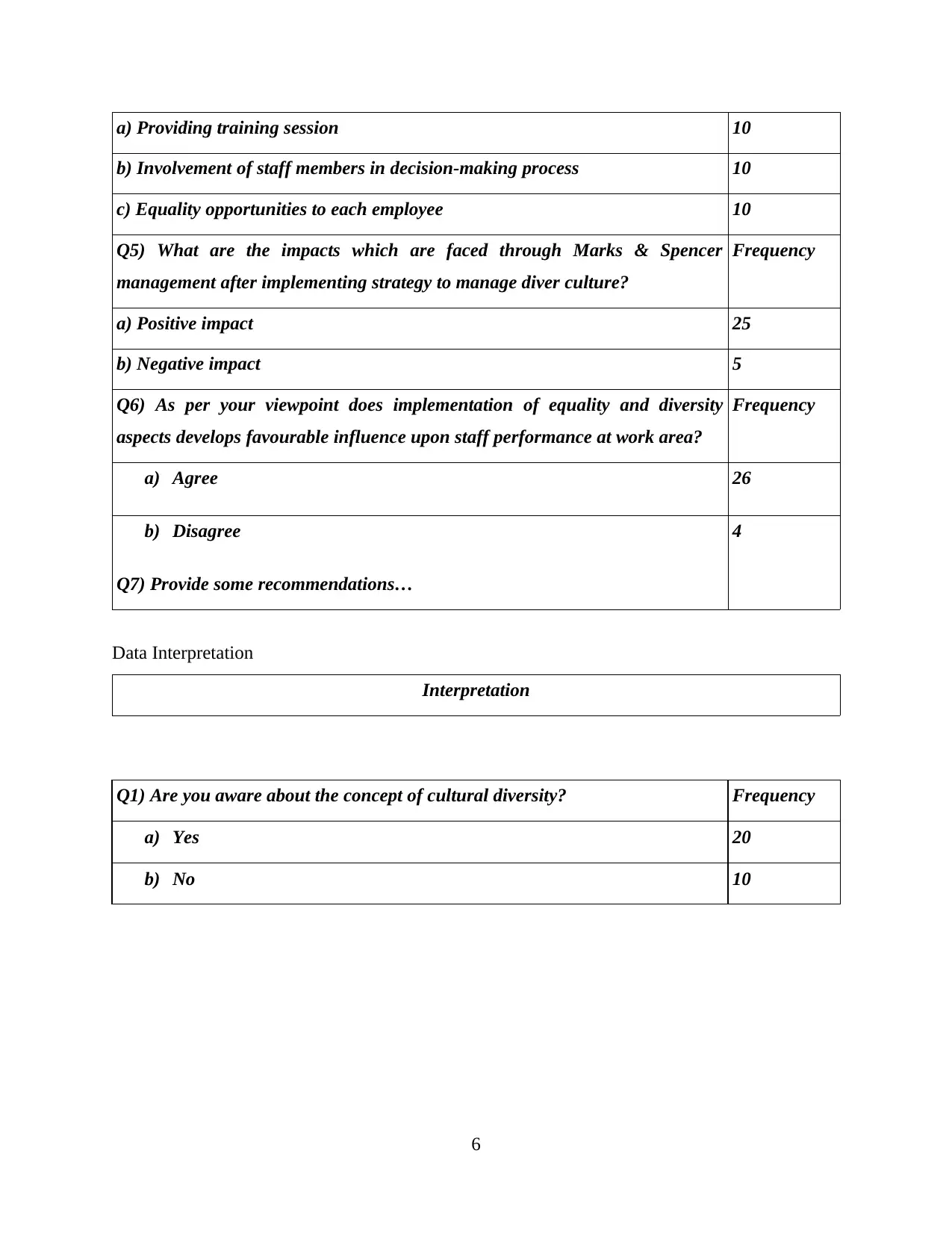
a) Providing training session 10
b) Involvement of staff members in decision-making process 10
c) Equality opportunities to each employee 10
Q5) What are the impacts which are faced through Marks & Spencer
management after implementing strategy to manage diver culture?
Frequency
a) Positive impact 25
b) Negative impact 5
Q6) As per your viewpoint does implementation of equality and diversity
aspects develops favourable influence upon staff performance at work area?
Frequency
a) Agree 26
b) Disagree 4
Q7) Provide some recommendations…
Data Interpretation
Interpretation
Q1) Are you aware about the concept of cultural diversity? Frequency
a) Yes 20
b) No 10
6
b) Involvement of staff members in decision-making process 10
c) Equality opportunities to each employee 10
Q5) What are the impacts which are faced through Marks & Spencer
management after implementing strategy to manage diver culture?
Frequency
a) Positive impact 25
b) Negative impact 5
Q6) As per your viewpoint does implementation of equality and diversity
aspects develops favourable influence upon staff performance at work area?
Frequency
a) Agree 26
b) Disagree 4
Q7) Provide some recommendations…
Data Interpretation
Interpretation
Q1) Are you aware about the concept of cultural diversity? Frequency
a) Yes 20
b) No 10
6
⊘ This is a preview!⊘
Do you want full access?
Subscribe today to unlock all pages.

Trusted by 1+ million students worldwide
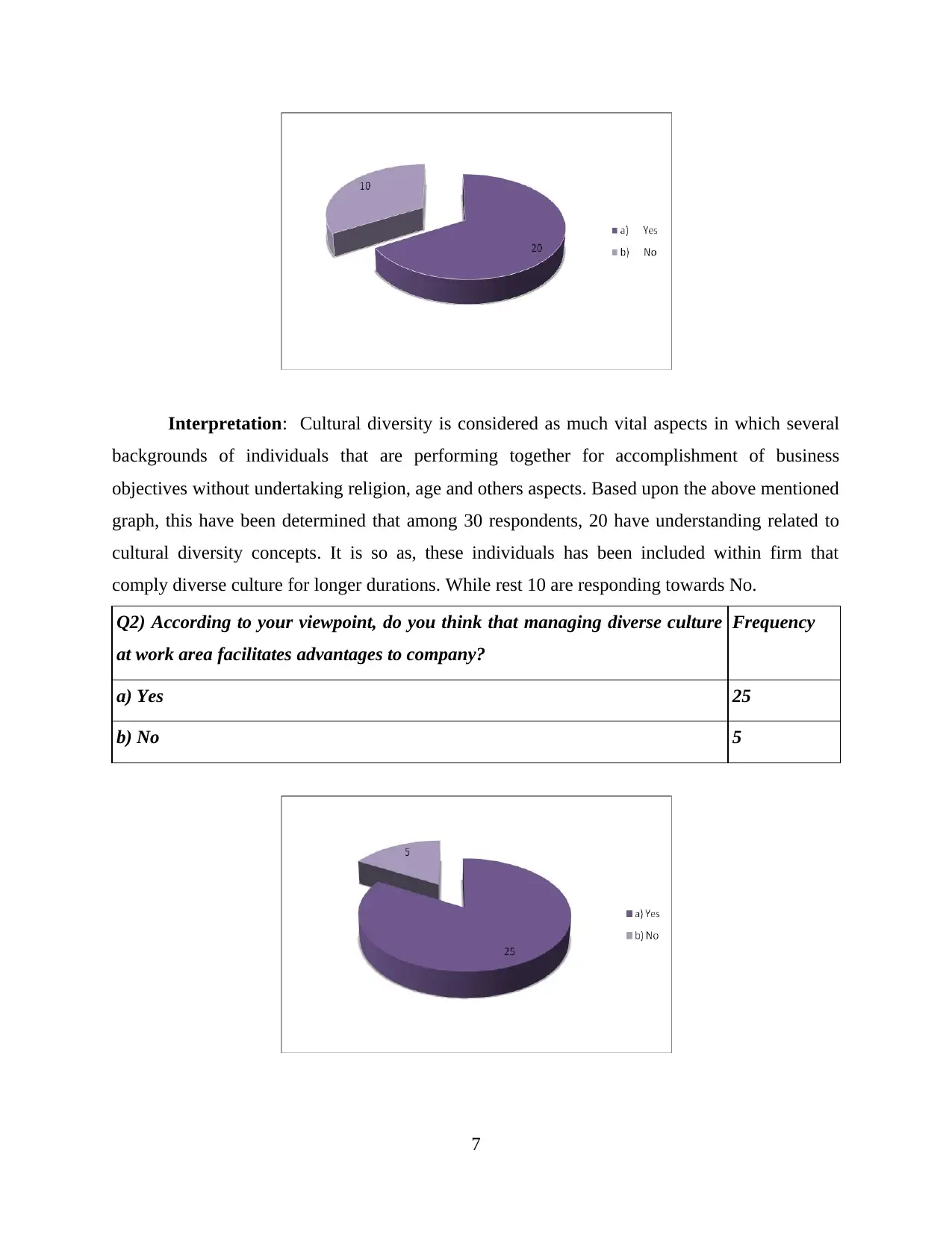
Interpretation: Cultural diversity is considered as much vital aspects in which several
backgrounds of individuals that are performing together for accomplishment of business
objectives without undertaking religion, age and others aspects. Based upon the above mentioned
graph, this have been determined that among 30 respondents, 20 have understanding related to
cultural diversity concepts. It is so as, these individuals has been included within firm that
comply diverse culture for longer durations. While rest 10 are responding towards No.
Q2) According to your viewpoint, do you think that managing diverse culture
at work area facilitates advantages to company?
Frequency
a) Yes 25
b) No 5
7
backgrounds of individuals that are performing together for accomplishment of business
objectives without undertaking religion, age and others aspects. Based upon the above mentioned
graph, this have been determined that among 30 respondents, 20 have understanding related to
cultural diversity concepts. It is so as, these individuals has been included within firm that
comply diverse culture for longer durations. While rest 10 are responding towards No.
Q2) According to your viewpoint, do you think that managing diverse culture
at work area facilitates advantages to company?
Frequency
a) Yes 25
b) No 5
7
Paraphrase This Document
Need a fresh take? Get an instant paraphrase of this document with our AI Paraphraser
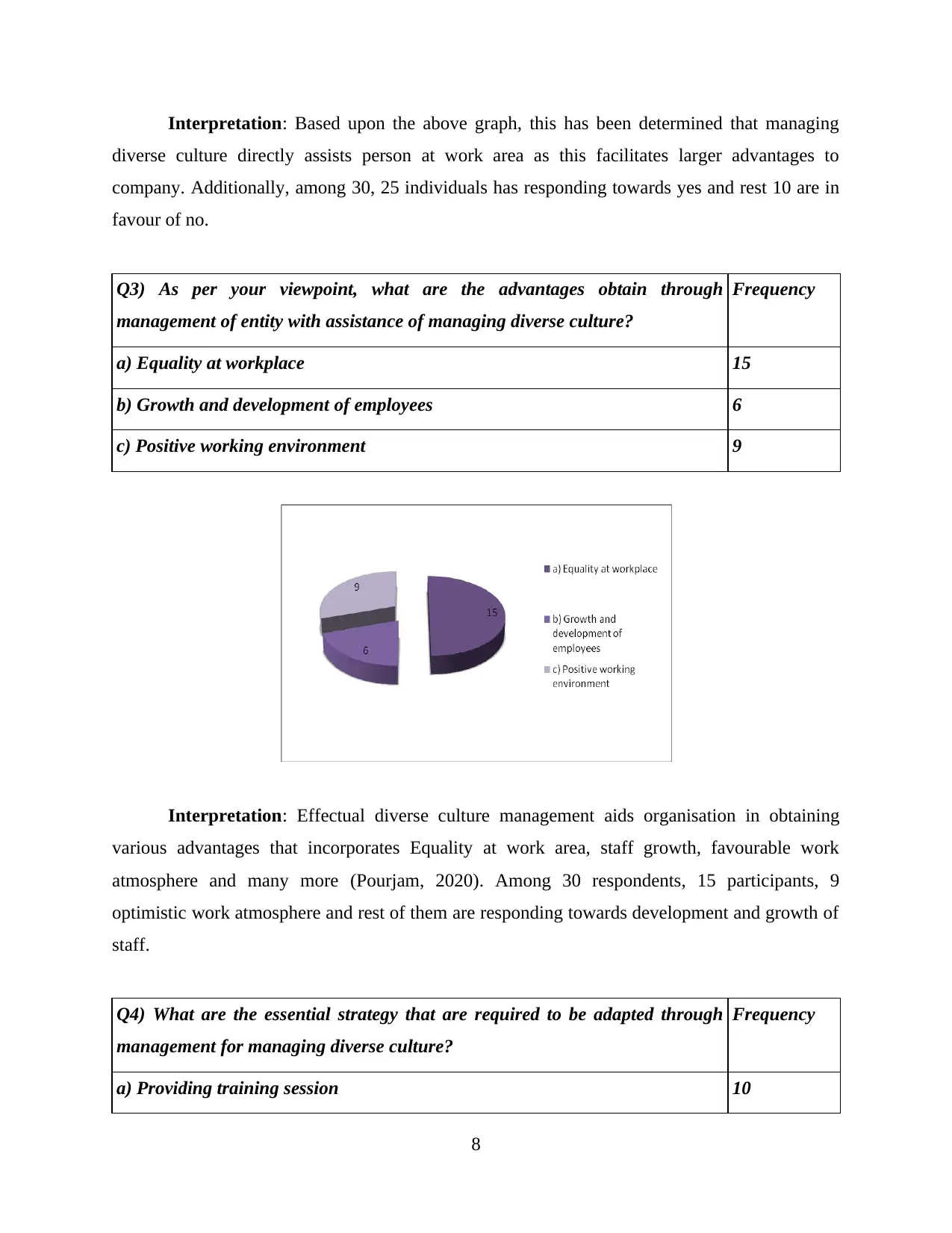
Interpretation: Based upon the above graph, this has been determined that managing
diverse culture directly assists person at work area as this facilitates larger advantages to
company. Additionally, among 30, 25 individuals has responding towards yes and rest 10 are in
favour of no.
Q3) As per your viewpoint, what are the advantages obtain through
management of entity with assistance of managing diverse culture?
Frequency
a) Equality at workplace 15
b) Growth and development of employees 6
c) Positive working environment 9
Interpretation: Effectual diverse culture management aids organisation in obtaining
various advantages that incorporates Equality at work area, staff growth, favourable work
atmosphere and many more (Pourjam, 2020). Among 30 respondents, 15 participants, 9
optimistic work atmosphere and rest of them are responding towards development and growth of
staff.
Q4) What are the essential strategy that are required to be adapted through
management for managing diverse culture?
Frequency
a) Providing training session 10
8
diverse culture directly assists person at work area as this facilitates larger advantages to
company. Additionally, among 30, 25 individuals has responding towards yes and rest 10 are in
favour of no.
Q3) As per your viewpoint, what are the advantages obtain through
management of entity with assistance of managing diverse culture?
Frequency
a) Equality at workplace 15
b) Growth and development of employees 6
c) Positive working environment 9
Interpretation: Effectual diverse culture management aids organisation in obtaining
various advantages that incorporates Equality at work area, staff growth, favourable work
atmosphere and many more (Pourjam, 2020). Among 30 respondents, 15 participants, 9
optimistic work atmosphere and rest of them are responding towards development and growth of
staff.
Q4) What are the essential strategy that are required to be adapted through
management for managing diverse culture?
Frequency
a) Providing training session 10
8
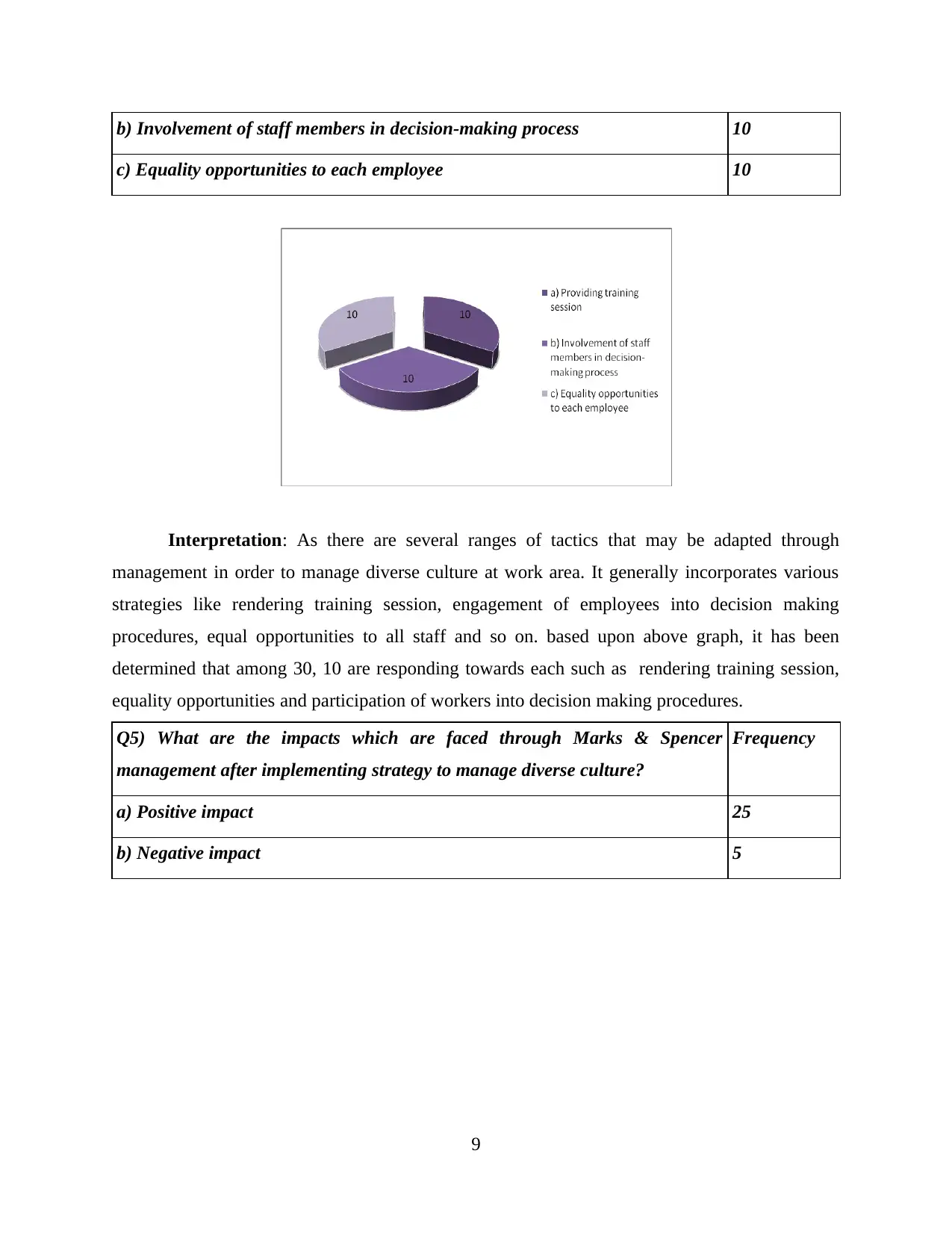
b) Involvement of staff members in decision-making process 10
c) Equality opportunities to each employee 10
Interpretation: As there are several ranges of tactics that may be adapted through
management in order to manage diverse culture at work area. It generally incorporates various
strategies like rendering training session, engagement of employees into decision making
procedures, equal opportunities to all staff and so on. based upon above graph, it has been
determined that among 30, 10 are responding towards each such as rendering training session,
equality opportunities and participation of workers into decision making procedures.
Q5) What are the impacts which are faced through Marks & Spencer
management after implementing strategy to manage diverse culture?
Frequency
a) Positive impact 25
b) Negative impact 5
9
c) Equality opportunities to each employee 10
Interpretation: As there are several ranges of tactics that may be adapted through
management in order to manage diverse culture at work area. It generally incorporates various
strategies like rendering training session, engagement of employees into decision making
procedures, equal opportunities to all staff and so on. based upon above graph, it has been
determined that among 30, 10 are responding towards each such as rendering training session,
equality opportunities and participation of workers into decision making procedures.
Q5) What are the impacts which are faced through Marks & Spencer
management after implementing strategy to manage diverse culture?
Frequency
a) Positive impact 25
b) Negative impact 5
9
⊘ This is a preview!⊘
Do you want full access?
Subscribe today to unlock all pages.

Trusted by 1+ million students worldwide
1 out of 18
Related Documents
Your All-in-One AI-Powered Toolkit for Academic Success.
+13062052269
info@desklib.com
Available 24*7 on WhatsApp / Email
![[object Object]](/_next/static/media/star-bottom.7253800d.svg)
Unlock your academic potential
Copyright © 2020–2025 A2Z Services. All Rights Reserved. Developed and managed by ZUCOL.




